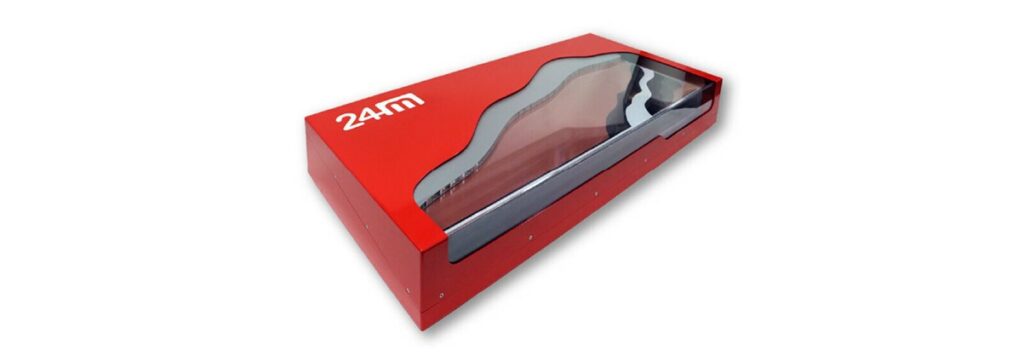Electrode-to-pack

In the quest for energy density in EV batteries, cell-to-pack (CTP) architectures represent an approach that increases the proportion of active materials by eliminating modules, and their associated structure and interconnections. Many examples of this type of architecture use hundreds or even thousands of relatively small cells, often in a cylindrical form with the electrodes wrapped into ‘jelly rolls’ and housed in protective ‘cans’. However, the cans themselves constitute an overhead of inactive materials that add weight and volume without adding energy.
With this in mind, 24M Technologies, based in Cambridge, Massachusetts, has taken a different approach to both pack architecture and electrode materials, making some bold claims about energy density, safety, longevity and sustainability along the way, writes Peter Donaldson.
The so-called electrode-to-pack (ETOP) architecture that 24M is developing represents a new branch of the CTP family tree. ETOP uses a much smaller number of much larger ‘sealed cathode-anode pairs’ in which each ‘SemiSolid’ electrode consists of active materials mixed with liquid electrolyte to form a thick slurry that eliminates the need for binders and significantly reduces the amount of inactive material.
The company refers to these structures as Unit Cells, as the anode and cathode do not need a separator between them. This is possible because the electrodes are thick and stable enough not to need a conventional physical barrier to prevent short circuits, their structure and formulation creating a natural separation.
Assembly of these cells, says 24M, takes six major steps instead of the 12 in the conventional process, as the semi-solid coating doesn’t need drying or calendaring, while the large format doesn’t need slitting, and the notching and electrode filling steps are removed.
Energy density is maximised through claimed electrode-packing efficiencies of 70-82%, which, says 24M, translates into the highest pack-level volume utilisation efficiency available. Along with the elimination of module enclosures and a reduction in the quantity of the cell structure, electrodes with a higher percentage of active materials, along with the lack of a separator, contribute to this packing efficiency.
The flat Unit Cells can be large, stacking up inside the pack envelope with their connector tabs in close proximity, allowing for both series and parallel connections while minimising the number of connections needed, further boosting energy density at pack level. This also speeds up pack assembly, making scaling to high production volumes easier.
These cells inherently have a large surface area to volume ratio, which improves their ability to dissipate heat, easing thermal management, and potentially leading to more consistent and reliable battery performance.
The simplified physical architecture of the cells improves the overall mechanical stability of the battery. Having fewer components reduces the risk of internal short circuits, while the thicker semi-solid electrodes provide a natural barrier to electron flow, which enhances safety, even in the face of mechanical abuse. Also, a simpler manufacturing process reduces the risk of defects.
Other touted benefits include fast charging at low temperatures, a long service life and capacity retention, longevity and ease of recycling. The latter comes largely courtesy of the lack of binders in the electrode mix, making the recovery of active materials much simpler.
The ETOP architecture can be used with both NMC and LFP chemistries, with 24M’s new ‘Eternalyte’ electrolyte, and with the addition of its dendrite-suppressing ‘Impervio’ separator technology, with lithium metal batteries, promising 1000 miles per charge and 500,000 miles of total range.
That’s a large number of bold claims for one set of technologies and it will be interesting to see how they pan out.
ONLINE PARTNERS































